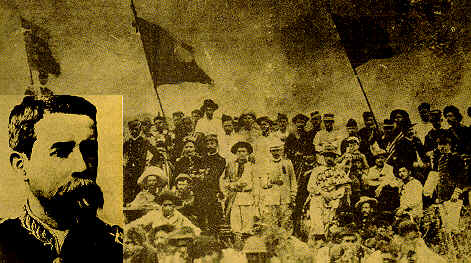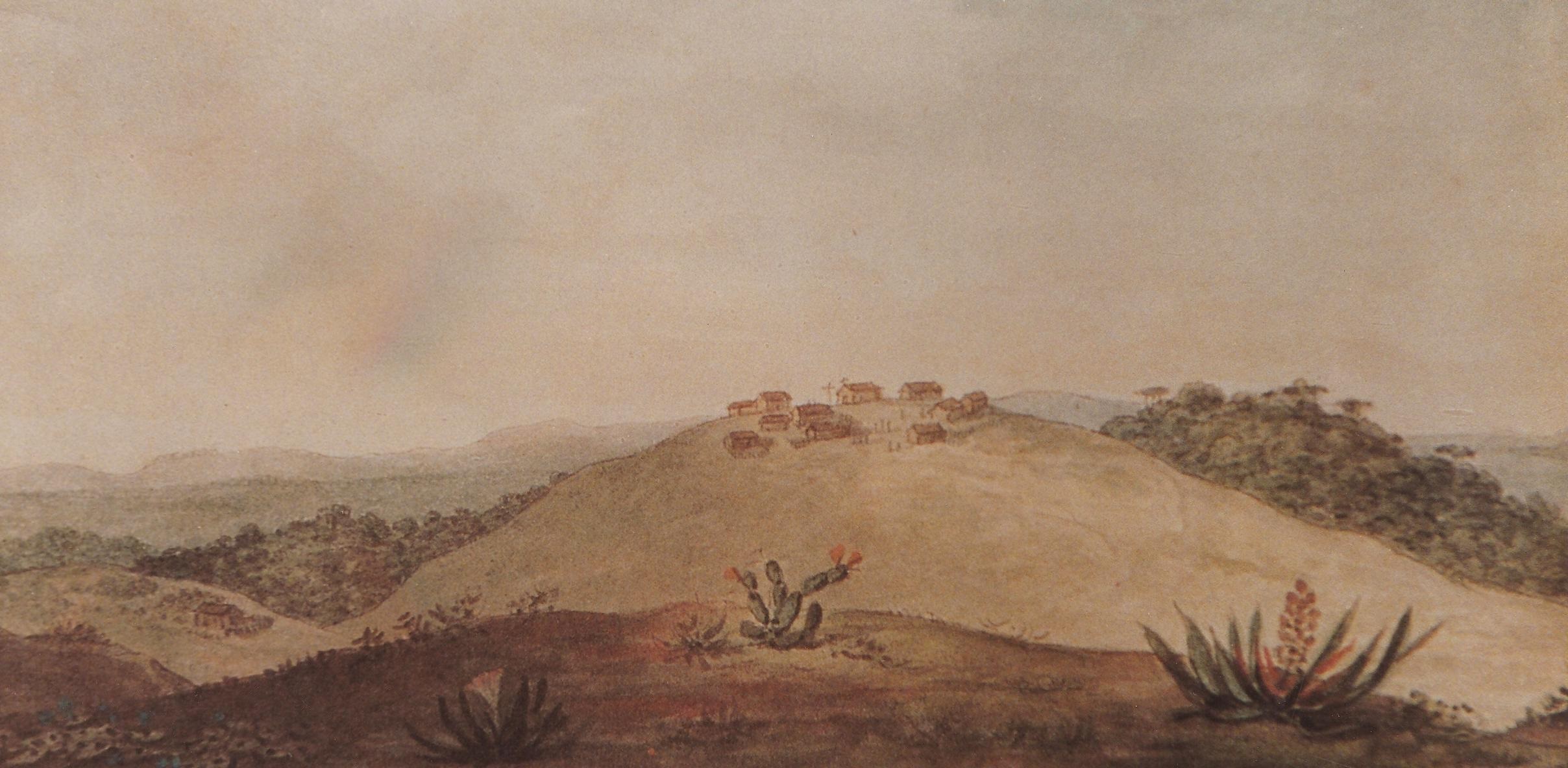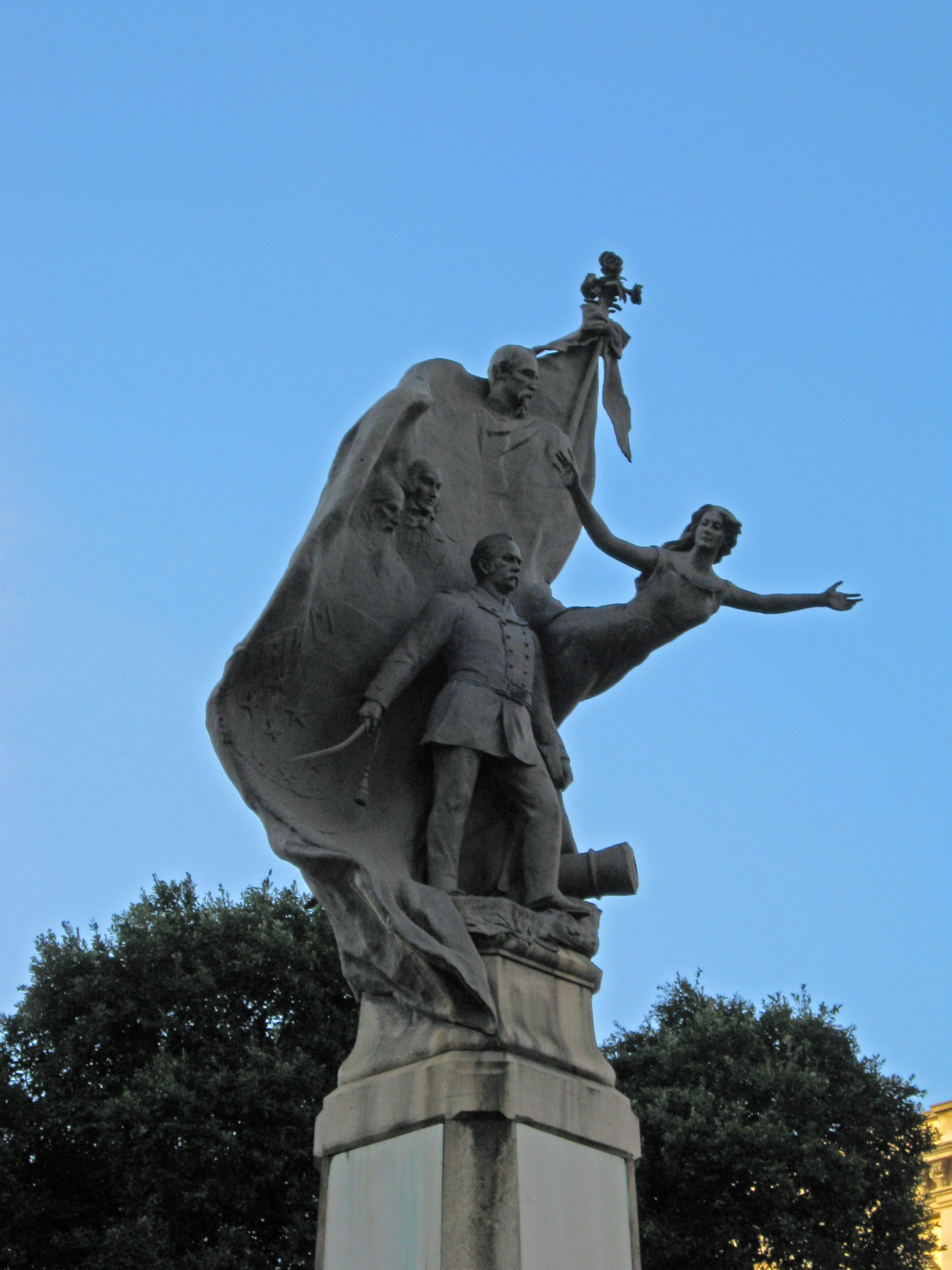|
Gumercindo Saraiva
Gumercindo Saraiva (Arroio Grande, January 13, 1852 – Carovi, Capão do Cipó, August 10, 1894) was a Brazilian soldier, being one of the commanders of the rebel troops known as '' maragatos'', during the Federalist Revolution. The beginning of the revolution In 1892, the Government of Júlio Prates de Castilhos entered a period of instability. With the state of Rio Grande do Sul at a boiling point, the Federalist Revolution was starting, with rebel troops being led by the general João Nunes da Silva Tavares, known as Joca Tavares. Saraiva decided to flee to Uruguay, where the rebel troops were gathering, after having refused to join the loyalist troops. On February 2, 1893, accompanied by his brother Aparicio Saravia and leading about 400 mounted troops, he crossed the border in a small town called Serrilhada, entering Rio Grande do Sul and joining the men of general Joca Tavares, thus forming the Liberator Army, a contingent of more than 3000 men. Shortly, newcomers inflate ... [...More Info...] [...Related Items...] OR: [Wikipedia] [Google] [Baidu] |
Arroio Grande
Arroio Grande (Portuguese meaning the big stream) is a Brazilian municipality in the southern part of the state of Rio Grande do Sul. The population is 18,238 (2020 est.) in an area of 2513.60 km². Its second industry is agriculture which was primary until the 1970s, it currently has more urban population (80%) than rural (20%). Much of the area is made up of plains. History The settlement was founded in 1803, around eighteen years before independence by Manuel Jerônimo de Sousa, who was Baron of Mauá's grandfather. In the right bank, the Ferreira family halted the construction, on the right bank, the sons of Manuel de Sousa Gusmão constructed secretly a ranch. Under law 54 of May 26, 1846, it was lifted to a parish as Nossa Senhora da Graça de Arroio Grande. Under law 596 on January 2, 1867, the municipality of Jaguarão was divided into five districts, one of which was Arroio Grande. Under the provincial law 843 on March 24, 1873, it became a town with a same nam ... [...More Info...] [...Related Items...] OR: [Wikipedia] [Google] [Baidu] |
Siege Of Lapa
The siege of Lapa was a military confrontation involving the Brazilian Army, the National Guard, the Military Police of Paraná state and civilian volunteers, which took place during the Federalist Revolution in early 1894. The city of Lapa became the arena of a bloody confrontation between the loyalist republican troops, commonly called ''pica-paus'' (woodpeckers) against the '' maragatos'', federalist rebels, who opposed the presidential form of government. The loyalists resisted the siege for 26 days, but succumbed due to the lack of ammunition and food. The siege gave president Floriano Peixoto enough time to gather and equip soldiers in São Paulo São Paulo (, ; Portuguese for ' Saint Paul') is the most populous city in Brazil, and is the capital of the state of São Paulo, the most populous and wealthiest Brazilian state, located in the country's Southeast Region. Listed by the Ga ... to fight back the federalist advance. The besieged forces numbered between 700 ... [...More Info...] [...Related Items...] OR: [Wikipedia] [Google] [Baidu] |
1852 Births
Year 185 ( CLXXXV) was a common year starting on Friday (link will display the full calendar) of the Julian calendar. At the time, it was known as the Year of the Consulship of Lascivius and Atilius (or, less frequently, year 938 '' Ab urbe condita''). The denomination 185 for this year has been used since the early medieval period, when the Anno Domini calendar era became the prevalent method in Europe for naming years. Events By place Roman Empire * Nobles of Britain demand that Emperor Commodus rescind all power given to Tigidius Perennis, who is eventually executed. * Publius Helvius Pertinax is made governor of Britain and quells a mutiny of the British Roman legions who wanted him to become emperor. The disgruntled usurpers go on to attempt to assassinate the governor. * Tigidius Perennis, his family and many others are executed for conspiring against Commodus. * Commodus drains Rome's treasury to put on gladiatorial spectacles and confiscates property to su ... [...More Info...] [...Related Items...] OR: [Wikipedia] [Google] [Baidu] |
Antônio Moreira César
Antônio Moreira César (July 9, 1850 – March 4, 1897) was a Brazilian army officer who fought on the side of the government forces in the Navy Revolt, the Federalist Revolution and the War of Canudos. He was governor of the state of Santa Catarina in 1894, where he ordered inummerous summary executions and murders, particularly the Baron of Batovi, a decorated hero of the Paraguayan War. Moreira César was killed in action fighting against the rebels of Antônio Conselheiro during the War of Canudos. Biography César was born in the state of São Paulo São Paulo (, ; Portuguese for 'Saint Paul') is the most populous city in Brazil, and is the capital of the state of São Paulo, the most populous and wealthiest Brazilian state, located in the country's Southeast Region. Listed by the GaWC a ... to Antônio Moreira César de Almeida (1814–1860) and his wife Francisca Correia de Toledo (1818–1895). Revolta da Armada (1893–1894) Federalist Revolution (1893–1895) ... [...More Info...] [...Related Items...] OR: [Wikipedia] [Google] [Baidu] |
Santa Vitória Do Palmar
Santa Vitória do Palmar (lit. "Saint Victoria of the Palms") is a Brazilian city and municipality. It is the southernmost municipality in Brazil, located in the state of Rio Grande do Sul. To the west of the municipality is the Lagoa Mirim and beyond that is Uruguay; to the east and southeast lies the Atlantic Ocean, and to the north is the city of Rio Grande. To the south, it borders the municipality of Chuí and Uruguay. The city proper is located approximately inland from the Atlantic, east of Lagoa Mirim and north of the Uruguayan border at Chuí. The city is traversed by the Brazilian federal highway BR-471, the most important road link between Brazil and Uruguay. It is by road from the state capital, Porto Alegre, and about from Uruguay's capital, Montevideo. Santa Vitória do Palmar used to be the southernmost city in Brazil, until the former village of Chuí was split from its territory and incorporated as a new city in 1997. However, while the ''urban seat'' of ... [...More Info...] [...Related Items...] OR: [Wikipedia] [Google] [Baidu] |
Itacurubi
Itacurubi is a municipality of the western part of the state of Rio Grande do Sul, Brazil. The population is 3,460 (2020 est.) in an area of 1,120.87 km². Its elevation is 169 m. The name comes from the Tupi language. It is located 627 km west of the state capital of Porto Alegre Porto Alegre (, , Brazilian ; ) is the capital and largest city of the Brazilian state of Rio Grande do Sul. Its population of 1,488,252 inhabitants (2020) makes it the twelfth most populous city in the country and the center of Brazil's fif ..., northeast of Alegrete. References External links Official Web Page www.citybrazil.com Municipalities in Rio Grande do Sul {{RioGrandedoSul-geo-stub ... [...More Info...] [...Related Items...] OR: [Wikipedia] [Google] [Baidu] |
Jaguarão
Jaguarão () is a municipality in the southern Brazilian state of Rio Grande do Sul located on the shores of the Jaguarão River, bordering Uruguay. It lies a short distance inland from the Mirim Lagoon. Geographical and historical proximity to Uruguay In 1865 it was the site of the Battle of Jaguarão, fought against Uruguayan forces. Located in the extreme south of Brazil and the border with Uruguay Uruguay (; ), officially the Oriental Republic of Uruguay ( es, República Oriental del Uruguay), is a country in South America. It shares borders with Argentina to its west and southwest and Brazil to its north and northeast; while bordering ..., the Baron of Mauá International Bridge links it with Río Branco. References External links Municipalities in Rio Grande do Sul {{RioGrandedoSul-geo-stub ... [...More Info...] [...Related Items...] OR: [Wikipedia] [Google] [Baidu] |
São Paulo (state)
São Paulo () is one of the Federative units of Brazil, 26 states of the Brazil, Federative Republic of Brazil and is named after Paul of Tarsus, Saint Paul of Tarsus. A major industrial complex, the state has 21.9% of the Brazilian population and is responsible for 33.9% of Brazil's GDP. São Paulo also has the List of Brazilian federative units by Human Development Index, second-highest Human Development Index (HDI) and GDP per capita, the List of Brazilian states by infant mortality, fourth-lowest infant mortality rate, the List of Brazilian states by life expectancy, third-highest life expectancy, and the List of Brazilian states by literacy rate, third-lowest rate of illiteracy among the federative units of Brazil. São Paulo alone is wealthier than Argentina, Uruguay, Paraguay, and Bolivia combined. São Paulo is also the world's twenty-eighth-most populous Administrative division, sub-national entity and the most populous sub-national entity in the Americas. With more than 4 ... [...More Info...] [...Related Items...] OR: [Wikipedia] [Google] [Baidu] |
Ponta Grossa
Ponta Grossa () is a municipality in the state of Paraná, southern Brazil. The estimated population is 355,336 according to official data from the Brazilian Institute of Geography and Statistics and it is the 4th most populous city in Paraná (76th in Brazil). It is also the largest city close to Greater Curitiba region, so within a radius of 186 miles (300 km) of Ponta Grossa. It is also known as ''Princesa dos Campos'' (in English: ''Princess of the Fields'') and ''Capital Cívica do Paraná'' (in English: ''Civic Capital of Paraná''). The city is connected to the ''Caminho das Tropas'' (in English: ''Path of the Troops''), being one of the network of routes used by drovers (''tropeiros'') in the middle of a high hill inside a grassy vegetation. The city is considered of average size, located around a central hill, while most of its growth occurred in the second half of the twentieth century with the weakening of the primary economy. Ponta Grossa is one of the larg ... [...More Info...] [...Related Items...] OR: [Wikipedia] [Google] [Baidu] |
Florianópolis
Florianópolis () is the capital and second largest city of the state of Santa Catarina, in the South region of Brazil. The city encompasses Santa Catarina Island and surrounding small islands, as well as part of the mainland. It has a population of 508,826, according to the 2020 IBGE (Brazilian Institute of Geography and Statistics) population estimate, the second-most populous city in the state (after Joinville), and the 47th in Brazil. The metropolitan area has an estimated population of 1,111,702, the 21st largest in the country. The city is known for having the country's third highest Human Development Index score among all Brazilian cities (0.847). The economy of Florianópolis is heavily based on information technology, tourism, and services. The city has 60 beaches and is a center of surfing activity. Lagoa da Conceição is the most famous area for tourism, recreation, nature, and extreme sports. ''The New York Times'' reported that "Florianopolis is the Party Destin ... [...More Info...] [...Related Items...] OR: [Wikipedia] [Google] [Baidu] |
Floriano Peixoto
Floriano Vieira Peixoto ( 30 April 1839 – 29 June 1895), born in Ipioca (today a district of the city of Maceió in the State of Alagoas), nicknamed the "Iron Marshal", was a Brazilian soldier and politician, a veteran of the Paraguayan War, and the second president of Brazil. He was the first vice president of Brazil to have succeeded the president mid-term. Election Peixoto was an army marshal when elected vice-president in February 1891. In November 1891, he rose to the presidency after the resignation of Marshal Deodoro da Fonseca, the first president of Brazil. Peixoto came to the presidency in a difficult period of the new Brazilian Republic, which was in the midst of a general political and economic crisis made worse by the effects of the bursting of the Encilhamento economic bubble. As Vice President, he had also served as the President of the Senate. Presidency His government was marked by several revolutions. Peixoto defeated a naval officers' rebellion ... [...More Info...] [...Related Items...] OR: [Wikipedia] [Google] [Baidu] |
Revolta Da Armada
The Brazilian Naval Revolts, or the Revoltas da Armada (in Portuguese), were armed mutinies promoted mainly by admirals Custódio José de Melo and Saldanha da Gama and their fleet of rebel Brazilian navy ships against the claimed unconstitutional staying in power of president Floriano Peixoto. First revolt In November 1891, President Marshal Deodoro da Fonseca, amid a political crisis compounded by the effects of an economic crisis, in flagrant violation of the new constitution, decided to "solve" the political crisis by ordering the closure of Congress, supported mainly by Paulista oligarchy. The Navy, still resentful of the circumstances and outcomes of the coup that had put an end to the monarchy in Brazil, under the leadership of admiral Custódio José de Melo, rose up and threatened to bombard the city of Rio de Janeiro, then the capital of Brazil. To avoid a civil war, marshal Deodoro resigned the presidency in 23 November. With the resignation of Deodoro, after just ... [...More Info...] [...Related Items...] OR: [Wikipedia] [Google] [Baidu] |

.jpg)



